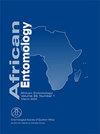Identification of alternative hosts of the tomato leafminer Tuta absoluta (Meyrick, 1917) (Lepidoptera: Gelechiidae) in West Africa
IF 0.6
4区 农林科学
Q3 ENTOMOLOGY
引用次数: 1
Abstract
Tuta absoluta (Meyrick, 1917) (Lepidoptera: Gelechiidae) reached West Africa in 2012 and has since become a major tomato pest. Various alternative strategies for pest control have been identified worldwide, including crop rotation, to deprive the insect of its food. However, this method can only be implemented if a good knowledge of the local host plants of the leafminer have been identified. Here, we have assessed the capacity of Tuta absoluta to develop on 27 common vegetable crops in West Africa, representing the Poaceae, Apiaceae, Convolvulaceae, Amaranthaceae, Malvaceae, Lamiaceae, Cucurbitaceae, Fabaceae, Brassicaceae, Asteraceae, Solanaceae, and Amaryllidaceae. The tomato leafminer was only able to develop and complete its life cycle on crops within the genus Solanum. Among the 27 plant species tested, Solanum lycopersicum L. (tomato) was identified as the best host, allowing for rapid development (22.2 ± 1.4 days) and a high survival rate (84%). Solanum tuberosum L. (Irish potato) (24.4 ± 0.8 days; survival rate 40%), Solanum aethiopicum L. (African eggplant) (24.3 ± 0.6 days; survival rate 52%) and Solanum melongena L. (eggplant) (25.9 ± 1.8 days; survival rate 24%) were three other possible hosts. Larval development occurred on onion (Allium cepa L.), but not pupation. A strategy that includes a prolonged absence of the genus Solanum in a production area would be associated with a considerable reduction in leafminer population size.西非番茄小叶蝉(Tuta absoluta, Meyrick, 1917)替代寄主的鉴定(鳞翅目:蠓科)
绝对灰蚜(Tuta absoluta, Meyrick, 1917)(鳞翅目:蠓科)于2012年传入西非,成为番茄的主要害虫。世界范围内已经确定了各种防治害虫的替代战略,包括作物轮作,以剥夺昆虫的食物。然而,这种方法只有在对叶螨的当地寄主植物有很好的了解的情况下才能实施。本研究对西非27种常见蔬菜作物——豆科、蜂科、旋花科、苋菜科、锦葵科、紫堇科、葫芦科、豆科、芸苔科、菊科、茄科和苋菜科进行了研究。番茄叶螨仅能在茄属作物上发育并完成其生命周期。在27种被试植物中,番茄(Solanum lycopersicum L.)发育快(22.2±1.4 d),成活率高(84%),是最佳寄主。Solanum tuberosum L.(爱尔兰马铃薯)(24.4±0.8天);存活率40%),非洲茄子(24.3±0.6 d);成活率52%)和茄(25.9±1.8 d);存活率24%),另外三个可能的宿主。洋葱(Allium cepa L.)上有幼虫发育,但不化蛹。一种包括在生产区域长期缺乏茄属的策略将与叶螨种群规模的大幅减少有关。
本文章由计算机程序翻译,如有差异,请以英文原文为准。
求助全文
约1分钟内获得全文
求助全文
来源期刊

African Entomology
生物-昆虫学
CiteScore
2.00
自引率
0.00%
发文量
17
审稿时长
6-12 weeks
期刊介绍:
African Entomology (ISSN 1021-3589 – print / 2224-8854 – online) replaced the old Journal of the Entomological Society of Southern Africa in 1993. A single volume consisting of two issues (March and September) is published annually. The journal is indexed in all major abstracting journals
African Entomology is a peer reviewed scientific journal that publishes original research articles and short communications on all aspects of entomology, with an emphasis on the advancement of entomology on the African continent.
 求助内容:
求助内容: 应助结果提醒方式:
应助结果提醒方式:


